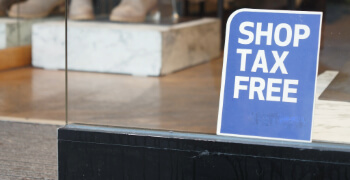There’s more than one way to carve, and tax, a pumpkin – Wacky Tax Wednesday
Americans are into Halloween, and not just for the candy. It’s the quintessential autumnal holiday, and for many, it’s not complete without a trip to a pumpkin patch for future jack-o’-lanterns. Corn mazes, hayrides, and pumpkin tosses are also part of the fun of the season, as are steaming mugs of apple cider, pumpkin bread, and other farm-made treats. Agritourism seems to hearken back to a simpler time — until you throw sales tax into the mix.
A trip to the farm
In Tennessee, a hayride is “an amusement, recreation, or entertainment activity” that’s generally subject to tax. However, the state allows an exemption for certain organizations, such as qualifying church or school groups, that purchase tickets directly and provide an exemption certificate. Admissions to a corn maze are similarly taxed.
That’s the simple part. The taxability of additional sales at farms quickly gets more complicated.
If the farmers offering such amusements sell farm produce to attendees, the produce is exempt from tax provided:
- At least 50 percent of the produce sold by the farmer is grown or produced by the farmer; and
- The charges for non-taxable produce are separately stated on an invoice from charges for taxable amusement, entertainment, and recreation.
Therefore, cornstalks and pumpkins grown at the same farm where they’re sold would be exempt. But what about pumpkins sold by a farm but grown elsewhere?
Me and Farmer Jones. When a farmer imports pumpkins to fill his or her depleted fields, the percentage of produce grown by that farmer declines. This can affect taxability. The department explains:
“If … agricultural products raised or produced by the farmer constitute at least 50% of all sales of livestock and poultry, nursery stock, farm and nursery products for the entire year, all of the farmer’s sales of these types of products made during the year are exempt from sales tax” [emphasis mine]. The percentage of other products produced and sold on-site (e.g., asparagus or lettuce) wouldn’t impact the taxability of pumpkins.
However, “if … products raised or produced by the farmer constitute less than 50% of all sales of these products for the entire year, the portion raised by the farmer are exempt but the portion obtained from other sources and sold by the farmer are subject to sales tax.”
It's worth sharing the department’s example. “If you produce 50% or more of the total pumpkins sold, then none of the sales of the pumpkins are subject to the sales tax. However, if you sold $800 of your own pumpkins and $1,200 worth of pumpkins produced by Farmer Jones, the sales of the $1,200 worth of pumpkins produced by Farmer Jones and sold by you are taxable. Sales of the $800 worth of pumpkins grown by you remain exempt.”
The same is true for use tax. Farmers that give self-produced pumpkins to school groups don’t need to pay use tax on those pumpkins provided at least 50 percent of pumpkins sold are grown on-site. If the farmer produces less than 50 percent of pumpkins sold or donated, the farmer owes use tax on the price of the pumpkins purchased and later donated.
Little wonder that the department stresses the importance of keeping accurate and detailed records.
Get cooking. Turn those pumpkins into pie or bread and taxability gets even more complex. Cooked food made entirely from the farm’s own produce or agricultural products is exempt if the charges are separately stated on receipts from taxable charges for amusement. Yet if the cooked or prepared food contains “any non-raised components or ingredients other than water, sugar, salt, pectin, or preservatives,” the charge is subject to state and local sales tax.
For example, corn grown on-site, boiled, and served plain would be exempt, while corn grown on-site, boiled, and slathered in butter would be taxable unless the butter was also produced on-site and made from milk produced by on-site cows.
Furthermore, a normally non-taxable prepared food sale would be taxable if combined with a taxable entertainment activity (e.g., if admissions to a corn maze gets you a steaming mug of farm-grown, farm-made apple cider).
Americans are expected to spend a combined $9.1 billion on Halloween this year, and some of that will surely be spent at farms on pumpkins, hayrides, and tasty treats. If you’re in the business of agritourism, be sure you know what’s taxable and what’s not. And remember, if you notice a customer who’s particularly curious about the ingredients of your pie, you could be in the presence of an auditor.
Learn more about the taxability of pumpkins in Pumpkin Patch Woes. If you have a sweet tooth and are curious about the taxability of Halloween candy, you’ll find some fun tidbits here.

Avalara Tax Changes 2026 is here
The 10th edition of our annual report engagingly breaks down key policies related to sales tax, tariffs, and VAT.
Stay up to date
Sign up for our free newsletter and stay up to date with the latest tax news.















